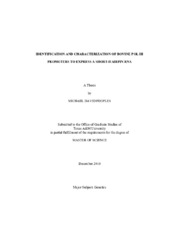| dc.description.abstract | The use of molecular biology as a means to advance agriculture has proven beneficial in many fields. However, the development lentiviral vectors that utilize a livestock promoter to express short hairpin RNA (shRNA) has been limited to date. The goal of this research project was to develop and characterize lentiviral bovine Pol III mir30 shRNA expression vectors for future use in livestock research. The bovine Pol III promoter (7sk, U6-2, or H1) was inserted directly upstream of a mir30 shRNA expression sequence in the lentiviral vector pNef-GT. A transient luciferase knockdown assay in human embryonic kidney (HEK) 293T cells was used to compare the functionality of these vectors. The bPol III mir30 shRNA expression vector was co-transfected with the pGL3 luciferase expression vector and the renilla expression vector pLB at a ratio of 5:10:1 respectively. The vectors were allowed 48 hrs to produce their respective products before luciferase activity was measured with the Stop-n-Glo Assay (Promega). Each bPol III promoter was able to express a functional shRNA resulting in a reduction of luciferase activity greater than 68 percent. The bH1 and bU6-2 Luc shRNA vectors were the most effective vectors when transfected with >76 percent (p-value <0.05) reduced luciferase activity. To confirm that these promoters were functional after integration into a bovine genome, recombinant lentivirus was made from these vectors. These particles were then used to transduce a bovine kidney (MDBK) cell line that expressed luciferase. After transduction, transgenic cells were selected by the addition of the antibiotic, Geneticin to the culture media until a population of 100 percent bPol III expression cells were observed for two passages and luciferase activity was measured. The 7sk promoter was the most effective bPol III promoter that reduced luciferase activity in these cells by 72 percent (p-value <0.05), while the bU6-2 and bH1 were moderately effective at reducing luciferase levels (37 percent, 46 percent respectively). These experiments were the first to quantify the bovine Pol III promoter function after integration into a bovine genome. While variability was observed, for livestock based research, the b7sk lentiviral vector appears to be the best choice to express a shRNA from the genome of a bovine genome. | en |


